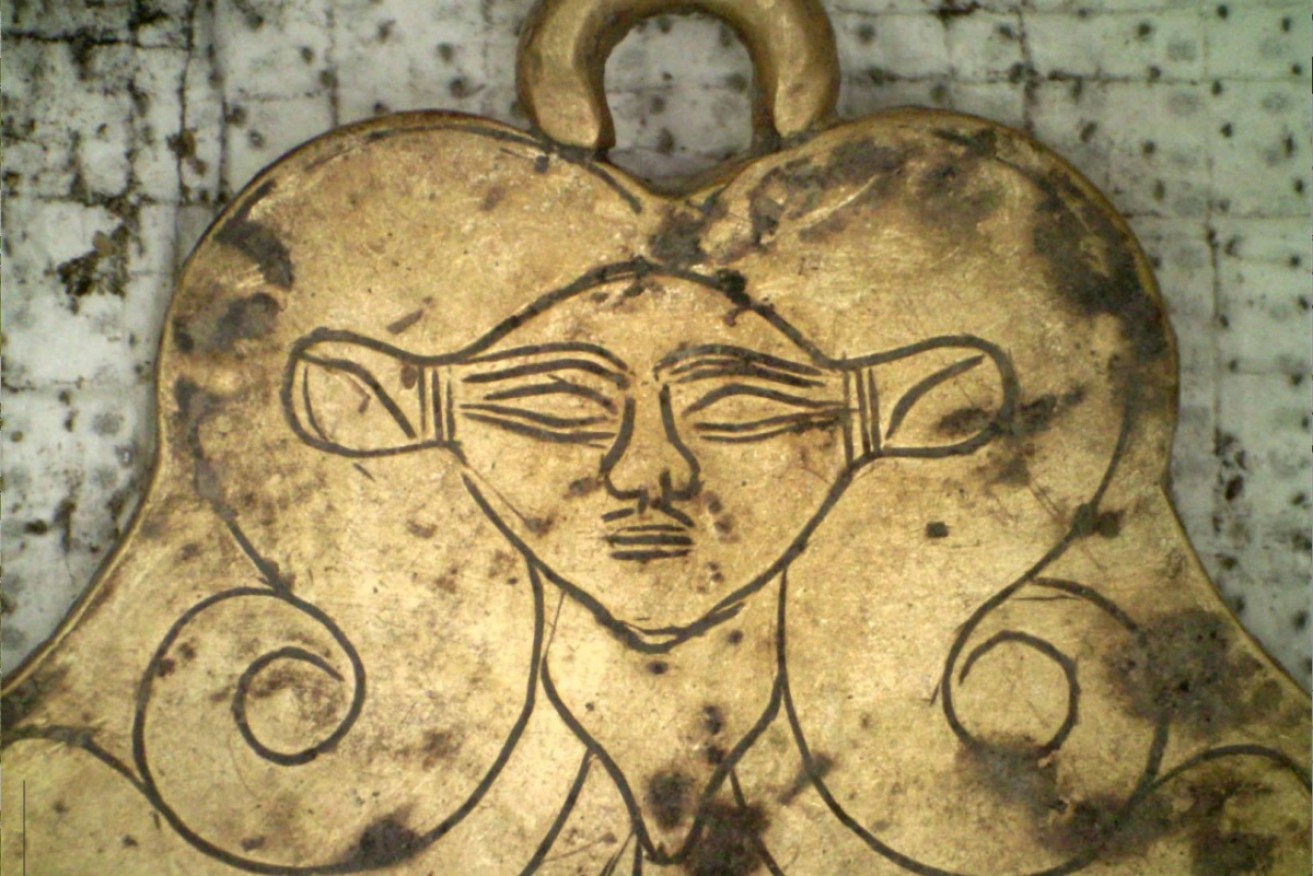Walls lined with gold: Ancient Greek tombs reveal their amazing treasures


A gold pendant featuring the likeness of Hathor, an Egyptian goddess, a protector of the dead. Photo: Vanessa Muro/UC Classics
Two Bronze Age family tombs have been discovered in Greece, their floors littered with gold leaf, indicating the walls were originally lined with the precious metal.
Although the tombs had been looted over the years, some beautiful treasures – and “a wealth of artefacts dating back more than 3500 years” – remained in place.
These included engraved jewellery, beads made of amber, a golden pendant featuring the head of the Egyptian goddess Hathor, who was believed to be a protector of the dead, and a “masterpiece” of Bronze Age art.
Perhaps the most astonishing finding was that of a gold ring decorated with a depiction of two bulls and barley grain.
“It’s an interesting scene of animal husbandry — cattle mixed with grain production. It’s the foundation of agriculture,” said Dr Jack Davis, one of the team leaders from the University of Cincinnati (UC) who made the discovery, in a prepared statement.
“As far as we know, it’s the only representation of grain in the art of Crete or Minoan civilisation.”
It’s now believed to be the first known depiction of domestic animals and agriculture in a single artwork from ancient Greece.

The historically significant gold ring found in the family tombs at Pylos depicts bulls and barley. Archaeologists believe it’s the first known depiction of domestic animals and agriculture in a single artwork from ancient Greece. Photo: Jeff Vanderpool/UC Classics
The beehive-shaped tombs – known as tholos – were discovered last year by Dr Davis and fellow UC archaeologist Dr Sharon R. Stocker at the extensive diggings in Pylos, Greece, a site they have been working since 1992.
The couple – they happen to be married – made their discovery while investigating the area around the grave of a long-dead man, now known as the “Griffin Warrior”, whom they discovered in 2015.

Stone lines the entrance to a grave called Tholos IV near the former Palace of Nestor, both discovered by the late UC Classics archaeologist Carl Blegen in 1939. Photo: UC Classics
They say “the princely tombs” overlooking the Mediterranean Sea contained a wealth of cultural artefacts and delicate jewellery that could help historians fill in gaps in our knowledge of early Greek civilisation.
“Like with the Griffin Warrior grave, by the end of the first week we knew we had something that was really important,” Dr Stocker said, who supervised the excavation.

A tiny sealstone from the tomb of the Griffin Warrior depicts mortal combat in exquisite detail. Archaeology Magazine called the sealstone “a Bronze Age masterpiece”. Photo: UC Classics
The Griffin Warrior is named for the mythological creature — part eagle, part lion — engraved on an ivory plaque in his tomb, which also contained armour and weaponry.
Among the “priceless objects of art” was an agate sealstone featuring two lion-like creatures, called genii, standing upright on clawed feet. They carry a serving vase and an incense burner, a tribute for the altar before them, Dr Stocker said.

The archaeologists found a carnelian sealstone featuring two mythological creatures called genii with serving vessels and incense over an altar. Above the heads of these creatures is a 16-pointed star, a symbol found elsewhere on the site and the meaning of which can’t be explained. Photo: Jeff Vanderpool/UC Classics
An intriguing feature of this piece is a 16-pointed star that sits above the heads of the genii. Dr Stocker said the same 16-pointed star also appears on a bronze and gold artefact in the grave – but the meaning of the star has been lost to history.
“One problem is we don’t have any writing from the Minoan or Mycenaean time that talks of their religion or explains the importance of their symbols,” Dr Stocker said.

Several gold pieces were found at the site, including this double argonaut. Photo: Jeff Vanderpool/UC Classics
According to a statement from the university, the identity of the Griffin Warrior is also a matter for speculation.
Dr Stocker said the combination of armour, weapons and jewellery found in his tomb strongly indicate he had military and religious authority – likely as a tribal king or military lord known in later Mycenaean times as a “wanax”.

An aerial view of the site shows the Tholos IV tomb, far left, found by archaeologist Carl Blegen in 1939 in relation to the two family tombs called Tholos VI and Tholos VII, uncovered last year by Jack Davis and Sharon Stocker. Photo: Denitsa Nenova/UC Classics
Dr Stocker said the family tombs also paint a picture of accumulated wealth and status – containing amber from the Baltic, amethyst from Egypt, imported carnelian and “lots of gold”.
The tombs sit on a scenic vista overlooking the Mediterranean Sea on the spot where the Palace of Nestor would later rise and fall to ruins – Nestor being the name of a famous character from both Homer’s Iliad and The Odyssey, generally accepted as the world’s works of literature.

The University of Witwatersrand in South Africa used facial reconstruction to see what the Griffin Warrior probably looked like. Image: Tobias Houlton and Lynne Schepartz
Dr Stocker said the antiquities provide evidence that coastal Pylos was once an important destination for commerce and trade.
“I think these are probably people who were very sophisticated for their time,” she said.
“They have come out of a place in history where there were few luxury items and imported goods. And all of a sudden, at the time of the first tholos tombs, luxury items appear in Greece.
“You have this explosion of wealth. People are vying for power. It’s the formative years that will give rise to the Classic Age of Greece.”

UC senior research associate Sharon Stocker works at the site of the Griffin Warrior in Pylos, Greece, in 2015. Photo: UC Classics
Palace of Nestor was discovered in 1939 by the UC Classics professor Carl Blegen. In the 1950s, Dr Blegen had wanted to excavate in the field where Dr Davis and Dr Stocker found the new tombs but could not get permission from the property owner to expand his investigation.
The tombs would have to wait 63 years for another UC team to make the startling discovery hidden beneath its grape vines.

Jack Davis and Sharon Stocker are continuing the legacy of the late Carl Blegen, pictured above, former head of UC’s Classics Department who discovered the Palace of Nestor in 1939 with Greek archaeologist Konstantinos Kourouniotis. Photo: UC Classics
UC’s team will continue working at Pylos for at least the next two years while they and other researchers around the world unravel mysteries contained in the artefacts.
“It has been 50 years since any substantial tombs of this sort have been found at any Bronze Age palatial site. That makes this extraordinary,” Dr Davis said.








